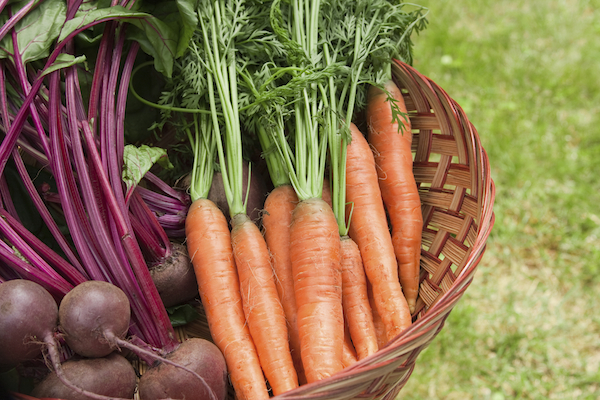
Basket full of root vegetables
Root vegetables have been used in recipes all over the world due to their low cost, nutritious value, accessibility, and they store well. There are numerous root vegetables to explore beyond the carrot, potato, onion, and beet.
Though, sometimes they might not be the most attractive items in the grocery store, but they are worth bringing to the kitchen table.
How can you not love these underground treasures?
These type of vegetables offer you all you need to sustain a healthy diet. Whether you follow a vegan, vegetarian, pescatarian or any other diet.
Root veggie are rich in vitamins, minerals, high in nutrients and antioxidants and the good side is that they’re very low in calories.
What else can you ask, right?
Try root vegetables recipes
There are many ways to enjoy your veggies. One of my favorite ways to eat root veggies is to roasting them!
It is a delicious and quick way to prep and enjoy. You could also try these hearty veggies mixed with salads, and or try them toasted instead of too many pastas and rice.
Tip: When shopping for root vegetables, go for the ones that are heavy and are firm for their size. Do not buy if they’ve wrinkles or are a bit shrivelled, bruised, and/or have any tender spots.
How to store them?
They are best stored in a cool, dark area. Keep it in paper bags if humid conditions. Make sure you don’t mix fresh green leafy with root vegetables.
If you follow the tips above, these may last for around two weeks. They are considered a winter vegetable, though you can usually find them almost everywhere all year round.
Roots are best described as vegetables that have fleshy edible underground parts. If we let them grow, they would provide nourishment to the plant in order for the plant to survive.
Other aspects and attributes:
Root vegetables can also be thought of as storage organs enlarged to hold energy in the form of carbohydrates. There are three main types of roots: true roots (which include taproots and tuberous roots), modified plant stems (which include rhizomes, corms, and stem tubers), and bulbs.
What are examples of root vegetables?
The example we can safely named different types of root veggies. The potatoes are in the tubers category -but you can see the remaining on list below:
Taproots
We are most familiar with these as they are the main part of the plant that absorbs nutrients and moisture as it grows vertically downward. Most known to us of taproots include:
Tuberous Roots
These are enlarged, roots – Examples of tuberous roots include:
- Earthnut
- Sweet potato
- Yuca
Rhizomes
Also known as creeping rootstocks. It is a fleshy horizontal plant stem that spreads below the soil surface and forms leaves above and thin roots below.
If a rhizome is separated into pieces, each piece would be able to produce a new plant, which is known as vegetable reproduction.
Examples of rhizomes include:
- Ginger
- Ginseng
- Wasabi
- Turmeric
Corms
It is a short, swollen underground or underwater plant stem whose inner structure is made up of solid tissue.
Corms differ from bulbs in that they have a solid interior, where bulbs are made up of individual layers. Few corms examples:
- Arrowhead
- Celery root
- Taro
- Water Chestnut
Stem Tubers
This is a swollen underground storage organ that forms from a thickened rhizome. The top and/or sides of the tuber produce shoots that grow into stems and leaves, while the underside produces roots. Tubers are known for storing large amounts of starch.
To name a few more examples:
- Jerusalem Artichoke
- Potato
- Yam
Bulbs
A bulb is a short stem with fleshy leaves that function as food storage organs during dormancy. Examples of bulbs include:
The benefits of these roots vebetables
The Beets, carrots, onions, turnips and sweet potato are all known for having super fighting qualities whilst protecting us from the majority of cancers.
Conclusion
The ones listed here are part of the healthiest root veggies we know. Although, the scientific can distinguish these underground plants into several varieties, you can be reassured that all provide you with great nutritious value for your money.
You might want to read this post, where we explain the reasons to eat fruit and vegetables.
If you are interested in this topic, subscribe to our newsletter and get new posts into your inbox. We do not sell or spam you.
Thanks for reading it.
Leave a Reply
You must be logged in to post a comment.